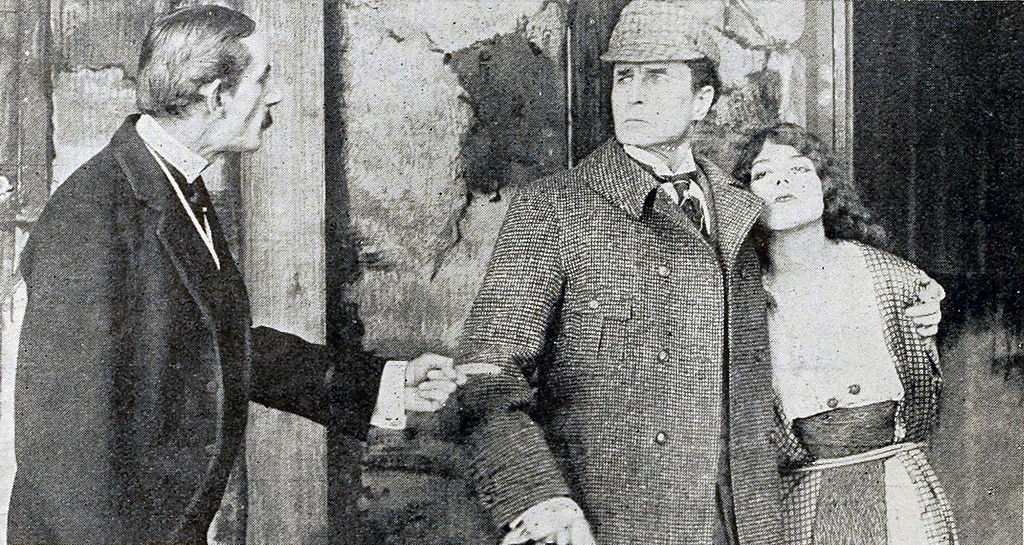Asexuality: Sherlock’s Biggest Mystery

Image: A publicity still from the 1916 Sherlock Holmes film, available under public domain / via Wikimedia Commons.
The most recent episode of BBC’s Sherlock aired on January 1, 2016, and featured Sherlock Holmes transported backwards in time in a “what-if” situation set in the 1890s.
No spoilers, but “The Abominable Bride” features a fun scene regarding Sherlock’s ever-mysterious sexuality. In the middle of Sherlock’s investigation, his thoughts are interrupted by Watson asking him if he’s ever had sexual desires for a woman. Sherlock responds with disgust and doesn’t want to talk about it, but Watson persists. The conversation is cut short when the men are forced to continue their investigation.
The problem with this scene lies in Watson’s inability to accept that Sherlock may have no romantic or sexual inclinations towards a woman or any other human being. Watson points out that Sherlock keeps on his person at all times a picture of Irene Adler, the only person to ever outsmart him. When Sherlock denies any attraction to her, Watson is confused.
For the 1890s, it’s possible that this is a characteristic reaction on Watson’s part, but in 2016 the reaction is less excusable. Steven Moffat, writer of the Sherlock series, claims that Sherlock is not asexual because asexuality would be too boring. In fact, in the Sherlock episode “A Scandal in Belgravia,” Moffat presents Adler as Sherlock’s potential love interest. And during the episode, Sherlock reasons that Adler could be in love with him.
However, “A Scandal in Belgravia” is an adaptation of “A Scandal in Bohemia,” in which Watson states that “It was not that [Sherlock] felt any emotion akin to love for Irene Adler. All emotions, and that one particularly, were abhorrent to his cold, precise but admirably balanced mind.” While Steven Moffat argues that “There’s no indication in the original stories that [Sherlock] was asexual or gay,” it seems to contradict the words of Sir Arthur Conan Doyle, the creator of Sherlock Holmes. Moffat’s refusal to acknowledge the possibility of asexuality for Sherlock is a prime example of asexual erasure.
Asexual erasure is a problem not limited to the Sherlock series, where many asexual fans cling to Sherlock as their identity finally being shown to the masses. Asexual erasure occurs all the time. It is almost impossible to think of a show, book, or film that has any asexual characters. The consequences can be dangerous. Asexuality becomes misrepresented and misunderstood, and many people who identify as asexual describe themselves as feeling broken due to their lack of sexual attraction. Asexuality is not a problem to be fixed — it is a valid identity.
Asexual erasure denies asexual people the right to see people like themselves represented in media. There is no one in mainstream media who is sharp, savvy, successful, and asexual. There is no mention of the spectrum of asexuality (grey-ace, demisexual, sex-repulsed, high libido asexual, etc.) or the fact that sexual attraction does not always equate to a lack of enjoyment of sex.
Asexuality is not the only sexuality to be erased. Bisexual erasure occurs far too frequently as well, and anything outside the monogamous heteronorm is unlikely to be portrayed in any sort of media as anything other than an abnormal lifestyle. So what is there to do?
Talk about it. Talk about the wide range of sexualities, talk about any LGBT+ characters in media, and talk about what makes them great and what makes them problematic. Do not let the media represent only heteronormative lifestyles.
When Sherlock returns to the small screen, gather up your friends and munch down on popcorn while counting every time Watson discounts Holmes’ lack of attraction. Tweet angrily at Steven Moffat. Make waves. Be interested, and note the small details. Make Sherlock proud.




